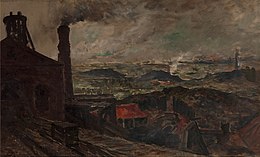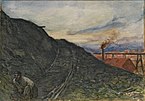Constantin Meunier
This article includes a list of general references, but it lacks sufficient corresponding inline citations. (August 2009) |
Constantin Meunier | |
|---|---|
 Self-portrait, 1885 | |
| Born | 12 April 1831 Etterbeek, Belgium |
| Died | 4 April 1905 (aged 73) Ixelles, Belgium |
| Occupation(s) | Painter, sculptor |
Constantin Meunier (French pronunciation: [kɔ̃stɑ̃tɛ̃ mønje]; 12 April 1831 – 4 April 1905) was a Belgian painter and sculptor. He made an important contribution to the development of modern art by elevating the image of the industrial worker, docker and miner to an icon of modernity. His work is a reflection of the industrial, social and political developments of his day and represents a compassionate and committed view of man and the world.[1]
Early life and education
[edit]Constantin Meunier was born in the traditionally working-class area of Etterbeek in Brussels. His family was poor and suffered from the negative economic impact caused by the Belgian Revolution which had taken place the year before Meunier's birth. Meunier's father committed suicide when he was just four years old.[2]

He began studying sculpture at the age of 14 at the Academy of Fine Arts in Brussels in September 1845.[3] He studied under the sculptor Louis Jehotte (1804–84) from 1848. He also attended from 1852 the private studio of the sculptor Charles-Auguste Fraikin.[4] While he encountered modestly success as a sculptor, his encounter with Gustave Courbet's social realist painting The Stone Breakers in 1851 caused him to doubt the ability of sculpture to adequate represent the contemporary social and artistic issues that were of concern to him. He therefore gave up sculpture in favour of painting which he practised almost exclusively for the next thirty years.[2]
Career
[edit]
Meunier's first exhibit was a plaster sketch, The Garland, shown at the Brussels Salon in 1851. His first important painting, The Salle St Roch (1857), was followed by a series of paintings including A Trappist Funeral (1860), Trappists Ploughing (1863), in collaboration with Alfred Verwee, Divine Service at the Monastery of La Trappe (1871) and episodes of the German Peasants' War (1878),[5] as well as of Belgium's own historical Peasants' War.
About 1880 Meunier was commissioned to illustrate those parts of Camille Lemonnier's description of Belgium in Le Tour du monde which referred to miners and factory-workers, and produced In the Factory, Smithery at Cockerill's, Melting Steel at the Factory at Seraing (1882), Returning from the Pit, and The Broken Crucible (1884).[5]

In 1882 he was employed by the government to copy Pedro de Campaña's Descent from the Cross at Seville, and in Spain he painted such characteristic pictures as The Café Concert, Procession on Good Friday, and The Tobacco Factory at Seville (Brussels Gallery). On his return to Belgium he was appointed professor at the Louvain Academy of Fine Arts.[5]
In 1885 he returned to sculpture and produced The Puddler, The Hammerman (1886), Firedamp (1889, Brussels Gallery), Le Débardeur (modeled 1885; many castings made 1889–1905), Ecce Homo (1891), The Old Mine-Horse (1891), The Mower (1892), The Glebe (1892), the monument to Father Damien at Louvain (1893), Puddler at the Furnace (1893), the scheme of decoration for the Botanical Garden of Brussels in collaboration with the sculptor Charles van der Stappen (1893), The Horse at the Pond, in the square in the north-east quarter of Brussels, and two unfinished works, the Monument to Labour and the Émile Zola monument, in collaboration with the French sculptor Alexandre Charpentier.[5]
The Monument to Labour, which was acquired by the State for the Brussels Gallery, comprises four stone bas-reliefs: Industry, The Mine, Harvest, and the Harbour; four bronze statues: The Sower, The Smith, The Miner, and the Ancestor; and a bronze group, Maternity.[5]
He was one of the co-founders of the Société Libre des Beaux-Arts of Brussels and was a member of the International Society of Sculptors, Painters and Gravers.[6]
Meunier was a freemason and a member of the lodge Les Amis Philanthropes of the Grand Orient of Belgium in Brussels.[7]
Meunier died in Ixelles on 4 April 1905.[8]
Works by Constantin Meunier
[edit]- Paintings
- Path descending from the slag heap
- Potato diggers
- Tobacco Factory, Sevilla
- Café del Buzero, Sevilla
- Unloading of a sailboat
- The Return of the Miners
- Female miner descending into the pit
- The organ grinder
- Sculptures
- The sower
- The Horse at the Pond 1899
- Man Battling with the Elements
- Autumn (Botanical Garden of Brussels)
Museum collections
[edit]In 1939, the Musée Constantin-Meunier dedicated to his work was opened in the last house in which Meunier lived and worked, in Ixelles, Brussels. Today about 150 of his works are displayed there.[9] M - Museum Leuven also holds a number of important works by Meunier,[10] as does Brussels' Fin-de-Siècle Museum. The Galleria d’arte moderna di Milano, one of the most important modern art collection in Italy, holds “The fisherman of Ostend”, 1850.
See also
[edit]References
[edit]- ^ Meunier in Leuven Archived 7 December 2021 at the Wayback Machine at M-Museum Leuven
- ^ a b Constantin Meunier, The return from harvest at dusk at Jean Moust
- ^ Ian Mundell, Retrospective reveals the Flemish inspirations of Constantin Meunier Archived 1 January 2021 at the Wayback Machine at Flanders Today
- ^ Pierre Baudson. "Meunier, Constantin." Grove Art Online. Oxford Art Online. Oxford University Press. Web. 6 March 2016
- ^ a b c d e Chisholm 1911.
- ^ "The International Society of Sculptors, Painters and Gravers". Mapping the Practice and Profession of Sculpture in Britain and Ireland 1851-1951. Glasgow University. Archived from the original on 1 July 2013. Retrieved 31 May 2013.
- ^ Berend Bunk, Les trésors du Temple: le Musée belge de la Franc-maçonnerie, Fonds Mercator, 2006, p. 109
- ^ Meunier, Constantin, and Sekula, Allan (2005). Constantin Meunier: A Dialogue with Allan Sekula. Belgium, Leuven University Press. p. 28. ISBN 9058674886.
- ^ "Constantin Meunier Museum". Belgian Tourist Office (Brussels-Wallonia). Archived from the original on 12 May 2013. Retrieved 9 April 2013.
- ^ Meunier in Leuven at M - Museum Leuven
Sources
[edit]- This article incorporates text from a publication now in the public domain: Chisholm, Hugh, ed. (1911). "Meunier, Constantin". Encyclopædia Britannica. Vol. 18 (11th ed.). Cambridge University Press. p. 315.
- P. & V. Berko, "Dictionary of Belgian painters born between 1750 & 1875", Knokke 1981, pp. 466–467.
External links
[edit] Media related to Constantin Meunier at Wikimedia Commons
Media related to Constantin Meunier at Wikimedia Commons- Works by or about Constantin Meunier at the Internet Archive


 French
French Deutsch
Deutsch












